
Road & Geosite Conditions
Fully Accessible
- Number
- Area
- 1. Ichiburi Geosite
- 2. Oyashirazu Geosite
- 3. Omi Coast Geosite
- 4. Omigawa Jade Gorge Geosite
- 5. Imai Geosite
- 6. Itoigawa-Shizuoka Tectonic Line and Salt Trail(North) Geosite
- 7. Maikomidaira Geosite
- 8. Hashidate Gold Mine Geosite
- 9. Kotakigawa Jade Gorge Geosite
- 10. Tsugami Shindo Geosite
- 11. Himekawa Gorge Via Oito Line Geosite
- 12. Itoigawa-Shizuoka Tectonic Line and Salt Trail(South) Geosite
- 13. Himekawa Gorge Geosite
- 14. Renge Geosite
- 15. Itoigawa Coast Geosite
- 16. Miyama Park and Museums Geosite
- 17. Tsukimizunoike Geosite
- 18. Umidani Gorge Geosite
- 19. Amakazariyama Geosite
- 20. Yakeyama Geosite
- 21. Benten-iwa Geosite
- 22. Shindosan Geosite
- 23. Gongendake Geosite
- 24. Tsutsuishi Hamatokuai Geosite
- Jade
- 1. Ichiburi Geosite
- 2. Oyashirazu Geosite
- 3. Omi Coast Geosite
- 4. Omigawa Jade Gorge Geosite
- 9. Kotakigawa Jade Gorge Geosite
- 15. Itoigawa Coast Geosite
- 16. Miyama Park and Museums Geosite
- Fossa Magna
- 5. Imai Geosite
- Itoigawa-Shizuoka Tectonic Line and Salt Trail(North) Geosite
- 11. Himekawa Gorge Via Oito Line Geosite
- 12. Itoigawa-Shizuoka Tectonic Line and Salt Trail(South) Geosite
- 13. Himekawa Gorge Geosite
- 17. Tsukimizunoike Geosite
- 21. Benten-iwa Geosite
- 22. Shindosan Geosite
- 24. Tsutsuishi Hamatokuai Geosite
- Mountainous areas
- 7. Maikomidaira Geosite
- 8. Hashidate Gold Mine Geosite
- 10. Tsugami Shindo
- 14. Renge Geosite
- 18. Umidani Gorge Geosite
- 19. Amakazariyama Geosite
- 20. Yakeyama Geosite
- 23. Gongendake Geosite

The cliffs at which the Northern Japanese Alps fall into the Sea of Japan were the product of terrestrial volcanic activity occurring about 100 million years ago. The ancient Hokuriku Road was wedged in a small space between these cliffs and the sea, making for a perilous journey, especially when the waves would surge. Large pockets and caves eroded into the wall where travelers would take refuge from the stormy seas still remain on the face of these cliffs.
During the Heian period (CE 794-1185), following their clan's defeat in the Genpei War, the wife of Taira no Yorimori followed her husband from Kyoto through these cliffs to the Kanbara District of Echigo Province, in what is now Nagaoka City. It was during this journey when her child was swept away by the raging waves. In memory of this, she composed the poem: "Oyashirazu ko wa kono ura no namimakura Koshiji no iso no awa to kieyuku" From this poem was born the name of these cliffs, Oyashirazu, 'without the parents knowing.'
During the Meiji era, a road was carved out halfway up the cliffs. During the Showa era a tunnel was built through the mountains, forever changing the shape of the Hokuriku Road. Finally, during the Heisei era, the fourth generation Hokuriku Expressway was completed. In addition to these four generations of roads, Oyashirazu also marks the origin of the Tsugami Shindo Road, making this the intersection of many roads from many ages. Here, where the sheer cliffs spread out against the Sea of Japan, gaze upon the many incarnations of the Hokuriku Road and enjoy a stroll along the shore where you just might find some jade!
 Tenken Oyashirazu
Tenken Oyashirazu
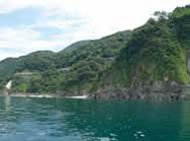 Cliffs of Oyashirazu
Cliffs of Oyashirazu
"Oyashirazu / Ko wa kono ura no / Namimakura
Koshiji no iso no / Awa to kieyuku"
Taira-no-Yorimori was a general of the once powerful Taira clan which was defeated by their rivals, the Minamoto clan, in the late 12th century.
After their defeat, Yorimori fled to what is now Niigata prefecture.
Following after him, his wife crossed Oyashirazu where she lost their child to the raging seas. In her sorrow she wrote this poem, which lends the cliffs their name.
"Without his parent knowing, my child, in this shore's waves along the Koshiji road, vanishes in the foam."
 Oyashirazu Community Road
Oyashirazu Community Road
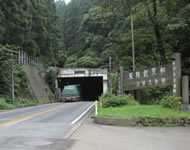 Oyashirazu Community Road Entrance by Tenken Tunnel
Oyashirazu Community Road Entrance by Tenken TunnelThe Oyashirazu Community Road was from 1883 until 1966 a national highway and the main thoroughfare carrying road traffic across Oyashirazu. It has since been repurposed as a recreational walkway.
At the entrance is a small pavilion where you can see a scale model of the cliffs and a statue of Rev. Walter Weston, an English clergyman who is often considered the Father of Japanese Mountaineering. From this pavilion you can see the Sea of Japan, the cliffs of Oyashirazu, and all four generations of roads that have crossed this area, from the old Hokuriku Road below along the coast, to the modern Hokuriku Expressway curving out over the sea.
 Katsuyama Fort Site
Katsuyama Fort Site
Sitting 328m above sea level atop Mt. Katsuyama, the Katsuyama Fort was built by the local ruling clan in the late 12th century. It served not only to protect the region from invasions from the western provinces, but it also looked over the Hokuriku Road, a vital trading route. It's location on a mountaintop allowed those stationed within to be able to see forts and castles in the Itoigawa and Nechi regions as well. This was used to great advantage as signal fires could easily and quickly alert others to impending attacks.
 JR Hokuriku Line and
JR Hokuriku Line and Mt. Katsuyama
 Letters on the Cliff
Letters on the Cliff
To commemorate the completion of the road in 1883, these characters were carved on the cliff face, reading "To no gotoku, ya no gotoshi."
"As smooth as a whetstone and as straight as an arrow," these words convey to us the sense of pride and accomplishment felt by the workers and engineers who had at long last bested this perilous cliff.
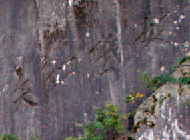 To no gotoku, ya no gotoshi
To no gotoku, ya no gotoshi
 The Start of the Tsugami Shindo Trail
The Start of the Tsugami Shindo Trail
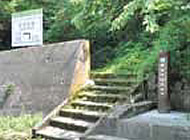
The Tsugami Shindo Trail is a unique mountain trail which connects the 3000-meter-high peaks of the Northern Alps with the Sea of Japan.
Constructed over a 10 year period starting in the 1960s, the trail starts near Oyashirazu Community Road at an elevation of 0m and ends at the peak of Mt. Asahidake at an elevation of 2418m. Here it connects with other mountain trails, offering access to higher peaks further inland.
Featuring a variety of elevations and topographical features, the trail is host to a variety of plants and wildlife, including many types of alpine flora.
Road Station "Oyashirazu Pier Park"
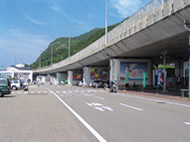
The Oyashirazu Pier Park is a Road Station, part of a network of roadside service areas and tourism facilities found along Japan's national highway system. The Pier Park opened in July 1988 to commemorate the completion of the Hokuriku Expressway, underneath which the Pier Park is uniquely located.
The Pier Park, features a beach, museum, restaurants, fish market, gift shop, and other amenities, including a bronze statue and murals designed by acclaimed artist Kiyoshi Awazu.
Route to Oyashirazu Geosite
Destination:


